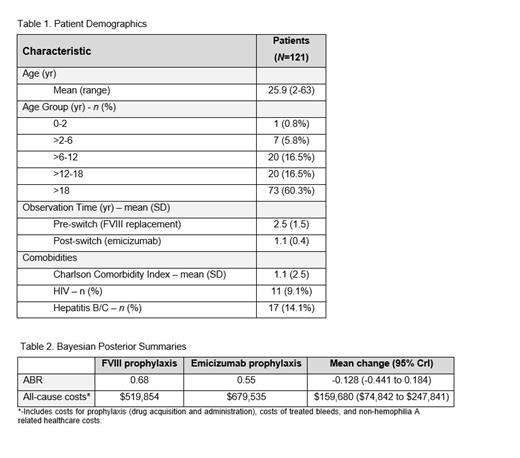Abstract
Background
Hemophilia A (HA) is a rare genetic disease characterized by a deficiency in clotting factor VIII (FVIII). Persons with HA suffer from spontaneous and traumatic bleeds which significantly impact short- and long-term quality of life. Prophylaxis treatment with FVIII replacement or non-factor replacement (e.g. emicizumab) intends to prevent bleeding episodes. To date, clinical comparisons between FVIII and emicizumab are limited to non-interventional studies and indirect comparisons. Comparisons of costs are limited to cost-effectiveness models or observational studies that include patients with and without inhibitors. An increase in availability of real-world data since emicizumab's approval in 2018 has created opportunity for comparative outcomes research in the non-inhibitor HA population.
Objective
To compare billed annualized bleed rates (ABR b) and all-cause costs (ACC) among non-inhibitor HA patients switching from prophylaxis with FVIII replacement to emicizumab.
Methods
This retrospective, observational, pre-post study used the IQVIA PharMetrics® Plus database (2015-2020)-a large longitudinal US commercial health plan database with over 190 million lives. International Classification of Diseases codes (ICD-10), National Drug Codes, and Healthcare Common Procedure Coding System were used to identify diagnoses, therapies, and procedures. Males with ≥1 claim for emicizumab who were on prophylaxis treatment with FVIII prior to initiating emicizumab were included in the analysis. Patients who received bypassing agents, immune tolerance induction, or rituximab were assumed to have inhibitors and were excluded. Patients with ≥2 occurrences of any of the following diagnoses were excluded: von Willebrand disease, hemophilia B, acquired HA, or other coagulation disorders.
Annualized bleed rate was defined as billed ABR and represents bleeding episodes that required evaluation, treatment, or procedure resulting in an ICD-10 claim. Therefore, bleeds treated at home and untreated bleeds were not captured. A clinical review of ICD-10 codes resulted in a list of 535 codes used to identify HA-related bleeding episodes (e.g. hemarthrosis). The ACC were calculated as the mean cost per patient per year in 2020 US dollars actually paid by the insurer. Descriptive statistics were used to summarize, and Bayesian models were developed to compare, ABR b and ACC in the pre- and post-switch periods. Bayesian inferences estimated the population mean difference in ABR b and ACC after switching from FVIII prophylaxis to emicizumab. Inferences were conducted by computing posterior probabilities for hypotheses and summarized with 95% credible intervals (CrI).
Results
A total of 121 patients were included with mean age [range] of 25.9 [2-63] years. The majority of patients were over the age of 18 (60.3%), 33.1% were ≥7-18, and 6.6% were <7. The mean (SD) years on FVIII replacement (pre-switch) and emicizumab (post-switch) were 2.5 (1.5) and 1.1 (0.4), respectively (Table 1).
Descriptive
In the majority of patients, ABR b remained unchanged from pre-switch to post-switch (42%) while 38% had some magnitude of improvement, and 20% experienced a worsening of ABR b. The mean observed ABR b and ACC were 0.68 and $518,151, respectively, in the pre-switch period, and 0.55 and $652,679, respectively, in the post-switch period.
Bayesian Model
The Bayesian model demonstrated a mean change in ABR b of -0.128 [95% CrI: -0.441 to 0.184] after switch (Table 2). The mean change in ACC was +$159,680 [95% CrI: $74,842 to $247,841] after switch. The model determined there is a 21.0% probability ABR b will worsen after switch and a 99.9% probability ACC will increase after switch.
Conclusions
Prophylaxis with FVIII replacement and emicizumab result in similar prevention of billed bleeds in a real-world switch population. Although the population mean ABR b is more likely to fall after switching from FVIII replacement to emicizumab, there is only a 1.02% posterior probability the population mean ABR b will fall by ≥0.5 after switching to emicizumab and a 21.0% probability the ABR b will worsen after switch. Additionaly, ACC are almost certain to substantially increase after switching to emicizumab (99.9%). As additional real-world data becomes available in the non-inhibitor HA population, further research should help to strengthen clinical and economic outcomes for different prophylaxis treatment options.
Batt: Sanofi: Current equity holder in publicly-traded company; Bayer Therapeutics: Consultancy; Sprouts Consulting: Other: CEO, Principal Consultant; Merck: Current equity holder in publicly-traded company; Forma: Consultancy, Current equity holder in publicly-traded company; Precision Health: Consultancy; Takeda Pharmaceuticals U.S.A.: Consultancy. Schultz: Takeda Pharmaceuticals U.S.A., Inc.: Current Employment, Current holder of individual stocks in a privately-held company. Caicedo: Takeda Pharmaceuticals U.S.A., Inc.: Current Employment, Current holder of individual stocks in a privately-held company, Current holder of stock options in a privately-held company. Hollenbeak: Takeda Pharmaceuticals U.S.A., Inc.: Consultancy. Agrawal: Takeda Pharmaceuticals U.S.A., Inc.: Consultancy. Chatterjee: Takeda Pharmaceuticals U.S.A., Inc.: Consultancy. Dayma: Takeda Pharmaceuticals U.S.A., Inc.: Consultancy. Bullano: Takeda Pharmaceuticals U.S.A., Inc.: Current Employment, Current holder of individual stocks in a privately-held company.


This feature is available to Subscribers Only
Sign In or Create an Account Close Modal